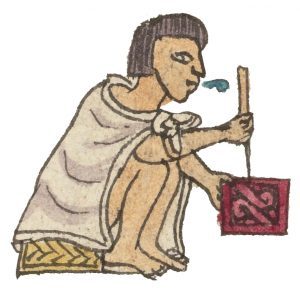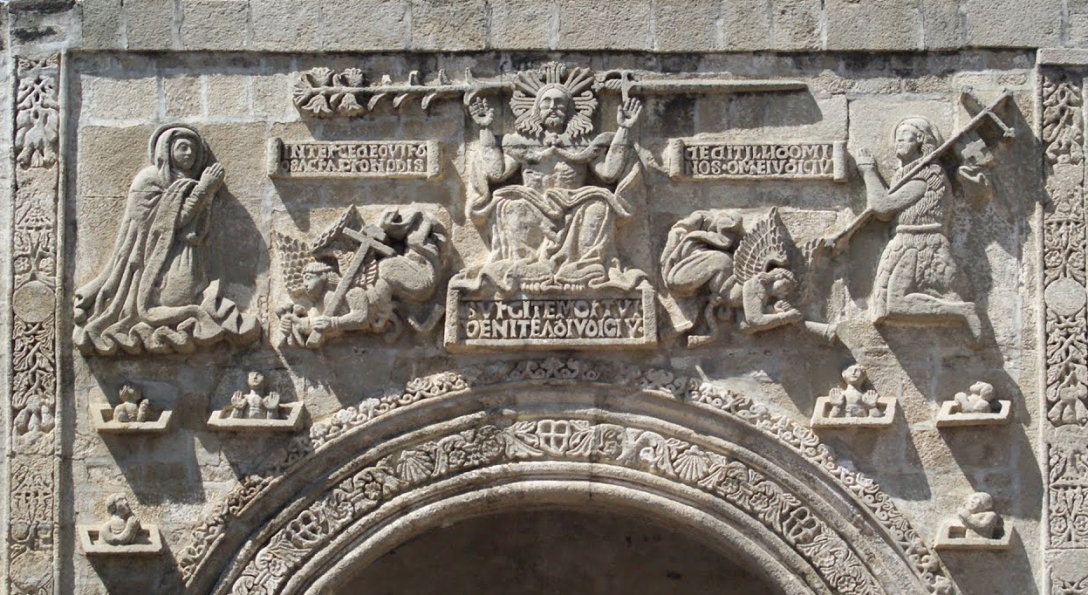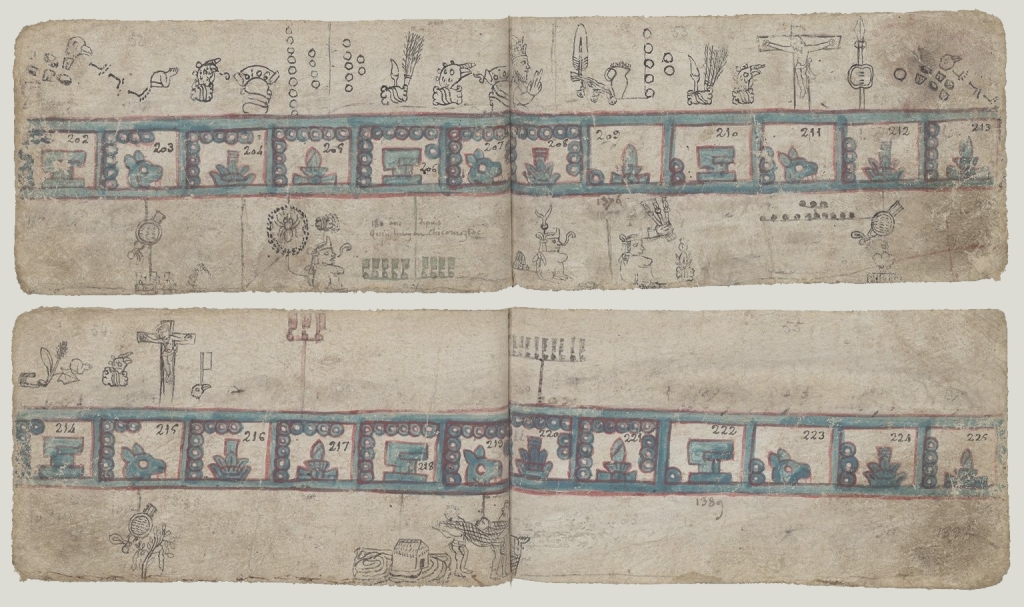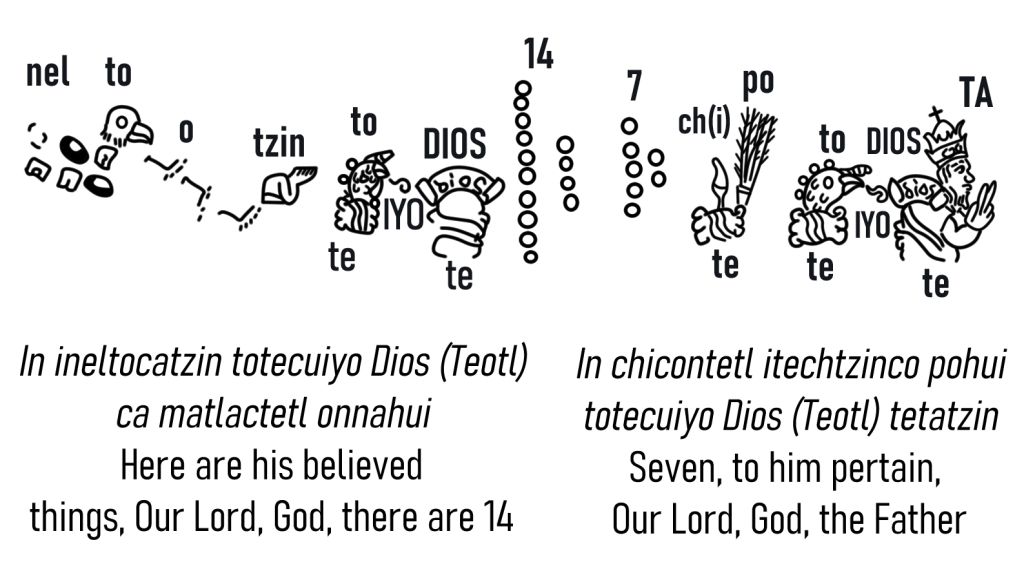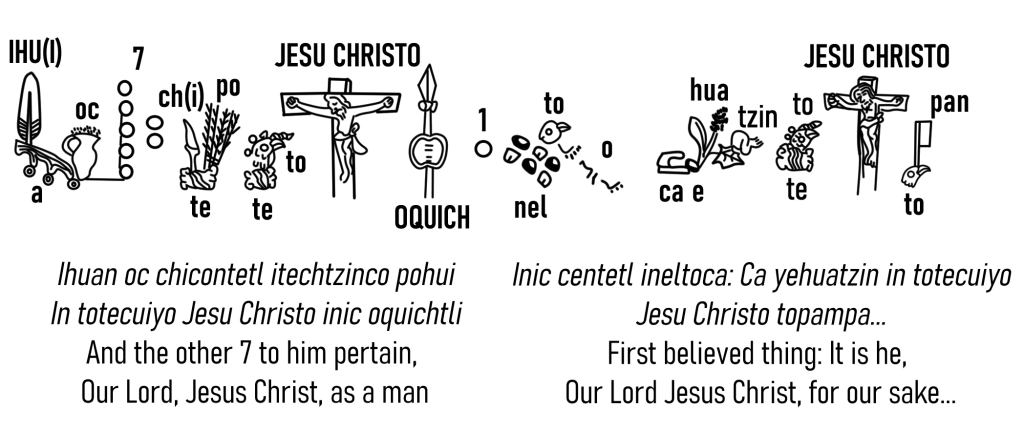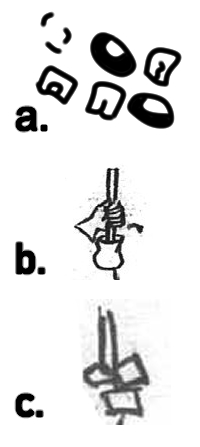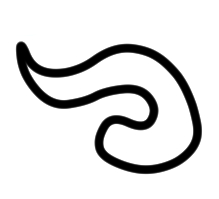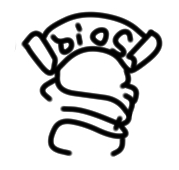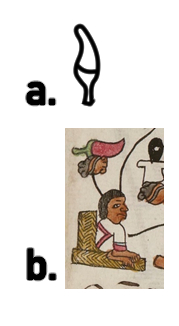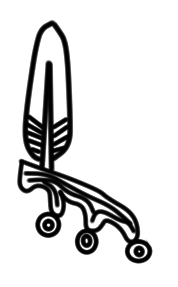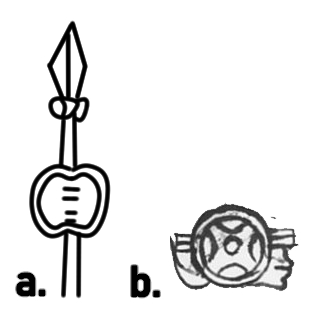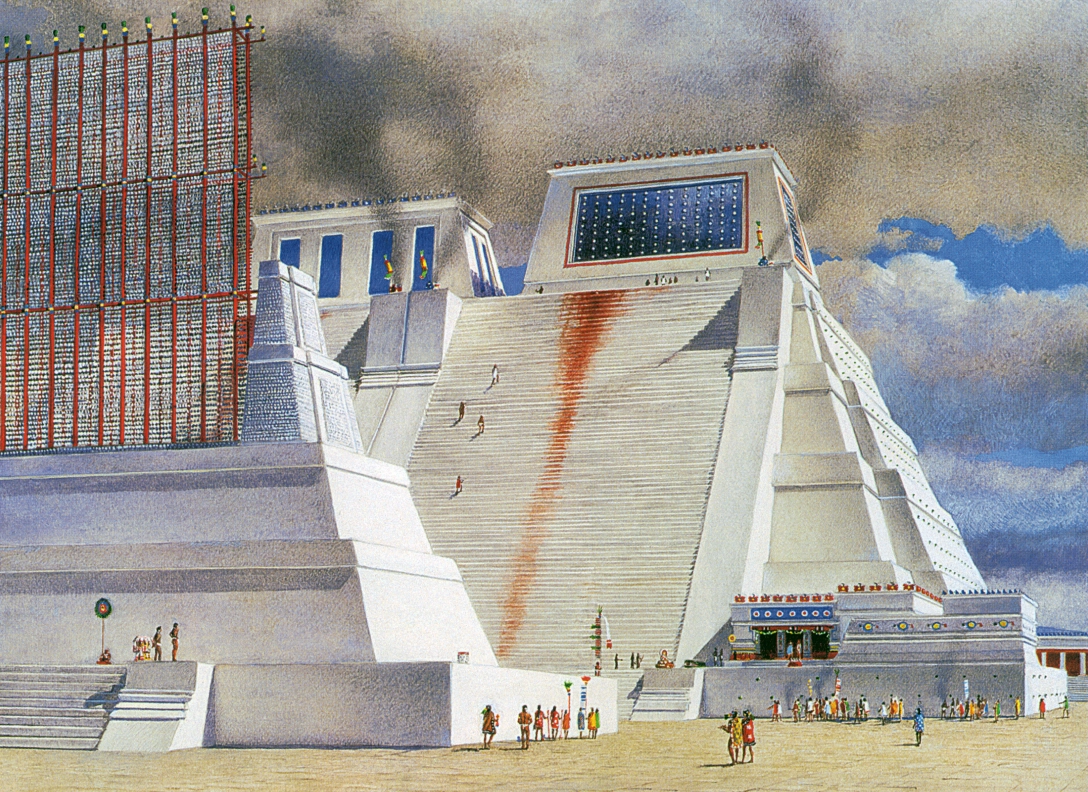Codex Osuna, a picto-glyphic and alphabetic colonial document in Nahuatl and Spanish (Cortés Alonso 1976), is a miscellany of documents which form part of “an inquiry into the conduct of Indian and Spanish governments by the visitador Valderrama in 1565″ (Glass 1975, 178), in which the grievances against both the indigenous government of Tenochtitlan and colonial Spanish functionaries are vividly portrayed. In particular, documents II and III, comprising folios 14 to 25 of the Codex, present a series of inquiries regarding the excessive number of personal services and forage demanded by a number of Spanish functionaries: the viceroy Luis de Velasco, the oidores (Audiencia judges) Dr Ceynos, Dr Bravo, Dr Zorita, Dr Orozco, Dr Puga, Dr Villalobos, Dr Villanueva, and a prosecutor, Maldonado. The aforementioned personages are not only portrayed iconographically, but their names are also written in Nahuatl logosyllabic glyphs. Some are rather easy to understand, while others still elude a convincing reading (Figure 1).

Figure 1. Spanish functionaries in Codex Osuna f. 15-19. a) TLATO-ix-e, Tlatoani visorrey, “Ruler, vicerroy” <gloss: donluys dVelasco.visorrey.>; b) tzapin, Zayn(os), Zaynos <gloss: doctor Çeynos.>; c) tol-i, (To)tol (O)i(dor), Doctor Oidor, “Doctor, judge of the Audiencia” <gloss: doctor brauo.>; d) zol, Zor(ita), Zorita <gloss: doctor Çorita>; e) ci-co, (Horo)zco, Horozco <gloss: doctor Horozco>, f) PURGA, Puga <gloss: doctor Puga.>; g) a-lo, Villalobos <gloss: doctor Villalouos>; h) ehua-a, (Villanu)eva, Villanueva <gloss: doctor Villanueva>; i) <gloss: el fiscal maldonado>, “The Fiscal Maldonado”.
Of course, all these glyphs deserve commentary. The glyph for visorrey or viceroy is common, but here it is complemented by the Nahuatl translation of the term, which is none other than tlatoani (Valle 2006: 114); Ceynos is, perhaps, still a mystery: the sign, formed by what seem to be a couple of crossed spines (huitztli), is rather similar to the logogram TZAPIN, Tzapin, “Piercer”, found in Matrícula de Huexotzinco 498r, which comes from tzapinia, “to prick, to pierce”, and in this case stands for the initial syllables of Zaynos, a variant spelling of the name in Spanish. Doctor Bravo still eludes a convincing reading: the rendering of the title doctor as to-tol or other variant is well attested in colonial documents (cfr. Valle 2006: 114), but the next glyph, which is the syllabogram i, bears no phonetic resemblance to the Spanish name Bravo. However, similar sequences formed by a “lip+water” element (which are inspired by the verb i, “to drink”) are constantly correlated to the title oidor in Codex Tlatelolco, as it happens with the name of oidor Francisco de Herrera, seemingly rendered o-i-el in page 7 (cfr. Valle 1994: 75); in the case of Dr Bravo in Codex Osuna, this breaks with the rest of the glyphs, which render the surname of the personages depicted rather than their titles, but since many of them are also doctores and oidores, and this is the only personage whom corresponding glyphs depict a title of his rather than his surname, an exception is most probably the case here. Puga, a name also spelled Purga (meaning “purge” in Spanish, a medical term) seems to be represented by a European influenced logogram, a topic that has been analysed in detail by Juan José Batalla Rosado (2015), and which is simply read PURGA. Finally, Maldonado, who is to be found in folios 19 and 25, is perhaps the most difficult of all: the sign, which visually resembles a crutch, seemingly has no counterpart in the extant corpus of Aztec writing. However, as I will show in this note, there is an iconographic parallel to this sign, a parallel that doesn’t have an easy reading, and instead forces us to “think outside of the box” in order to propose a plausible reading.
The “crutch” sign that denotes Maldonado’s name can actually be found in a rather different context: Codex Telleriano Remensis, 41v (Figure 2). The contraption has the same iconography: it resembles an open wooden peg or a gripper with a red oval in one of its extremes. But what is it? Luckily, the episode depicted, associated to the year 13 House or 1505, is well understood thanks to its accompanying Spanish gloss: It is a famine that lasted two years, the second of which is none other than the dreaded year 1 Rabbit, famous for famines, to the point that there was a specific verbal expression, necetochhuilia, “to become like the year 1 Rabbit”, to denote the much-feared effects of such date, which were recurrent and cyclical, since similar famines always happened in years in the same sign, such as 1454, where the famine is depicted by the accompanying illness that it caused in Telleriano Remensis 32r. In the case of the famine of 1505, the gloss clarifies: “Year of 13 Houses (sic) and 1505: There was a great famine in the province of Mexico, they went for bread to the province of Panuco” (Quiñones Keber 1995, 174). Correspondingly, we see a man with his travelling staff, porting a bundle on a carrying frame on his back. But… what is the “crutch” sign that is associated to the bundle itself?

Figure 2. The “crutch” sign: a) The famine of the year 13 House (1505). Codex Telleriano Remensis, 41v; b) A comparison between the Maldonado glyph and the element atop the traveller’s bundle in Telleriano-Remensis.
The explanation is to be found in parallel depictions of the same event in other documents. In Codex Chimalpopoca, it is clarified: In ipan inin xihuitl in netotonacahuiloc, ompa ontlaolmamaloya in Totonacapan inic cenca mayanaloya, “Also in that year, they became Totonacs, because they carried shelled corn from Totonacapan because there a was great famine” (Tena 2011: 204). Effectively, the first verbal expression used is netotonacahuiloa, “to become a Totonac”; this expression is glossed by the lexicographer Wimmer as “evoking the Mexicans who sold themselves to the Totonac to survive famine” (Wimmer 2004). Effectively, at that time people only had themselves to give in exchange for corn: they sold themselves into slavery to the Totonac, who had corn in abundance. Most curiously, this behaviour was cyclical! In Codex Aubin 35r, the great famine of 1453 (Year 1 Rabbit) is depicted by people who carry wooden collars (tlacotl or cuauhcozcatl) in order to sell themselves as slaves. The crude depiction of the Aubin is a less detailed variant of a more detailed iconography: the cuauhcozcatl usually consisted in a wooden collar, often covered with cloth, traversed by a long stick or wooden cinch. The Telleriano Remensis resembles an iconographic usage in Mesoamerican codices, in which the merchandise sold by the pochteca is depicted atop their Cacaxtli, as it famously happens in Codex Borgia 55, as Eric Thompson established (1966). Thus, the “crutch” element found in both Telleriano Remensis and Osuna is actually a tlacotl, a slave collar. However, having achieved this iconographic identification, we are still in a dilemma, because the tlacotl sign in Nahuatl writing usually has the reading value of TLACO(TL), tlacotl, “wooden collar”, but can also be used to denote the word tlaco, “half, that in the middle”, as found in Matrícula de Huexotzinco 576v (Figure 3).

Figure 3. a) People selling themselves as slaves in the great famine of the year 1 Rabbit or 1453 (Codex Aubin 35r); b) Feather merchant (Codex Borgia 55); c) The name “Pedro Tlaco”: TLACO, tlaco, “middle brother”, Matrícula de Huexotzinco 576v <gloss: pe°. tlaco>.
Thus, the problem remains: the reading value usually associated with this sign doesn’t make sense, sounding nowhere close to the name Maldonado or to the Spanish title fiscal (“prosecutor”), another possibility. Thus, we found ourselves in an impasse. At this point of the riddle, it is perhaps useful to start “thinking outside the box”, in terms of the theory of Nahuatl writing that I have advanced elsewhere (Zamora 2022). The usual logographic value of TLACO(TL) is indeed unrelated to the name depicted in Osuna, as is the synonymous expression cuauhcozcatl; however, there is another word that phonetically fits perfectly to solve the problem, and which is associated to the episode depicted in Telleriano-Remensis in other Aztec historical accounts. Indeed, the “keyword” that summarises accounts of famine in either pictographic or purely alphabetic Aztec colonial texts is mayanalo, “one is hungry, everyone is hungry, there is famine”, the impersonal form of mayana “to be hungry” (Karttunen, 1983: 141). It appears in past perfect in Aubin (mayanaloc, “there was hunger”) and imperfect in Codex Chimalpopoca (mayanaloya “there was hunger” (Codex Chimalpopoca), but the root is a perfect phonetic fit for the Spanish name: mayanalo=Maldonado. Thus, this glyph is the equivalent, in Nahuatl writing, of how, for example, the Spaniards transcribed Huitzilopochtli as “Huichilobos” or Cuitlahuac as “Cuedlavaca” (Figure 4). Since this is a phonetic approximation, rather than an exact logographic rendering (unlike Purga, for example), I shall transcribe it as a complex syllabogram, rather than as a logogram, as recently proposed by Gordon Whittaker (2022), but those otherwise inclined can read it as a logogram MAYANA.

Figure 4. mayanalo, Maldonado, <gloss: el fiscal maldonado>, “The Fiscal Maldonado”, Codex Osuna 19.
Of course, this sign is exceptional, since its reading value, in this particular context, is borrowed from the value that it has in a more pictographic context, rather than from the value that it has in the usual logographic system. If the proposal is correct, it would show that we need to start seriously considering the verbal messages behind what has been vaguely termed as “iconography” in Aztec codices, in order to further our understanding of elements in the system that have not been read in a plausible way until now, perhaps owing to the limits of our particular scope.
Addendum
Marc Thouvenot has brought to my attention a glyph that appears in Matricula de Huexotzinco 606v and 904v, depicting the very curious name Diego Amatlacuilol, the Nahuatl part meaning “scribe” (Figure 5). The glyph is formed by a piece of paper with scribblings on it, held by the “gripper” element discussed above. While thinking about the proposal of this article, I actually considered it as a very close iconographic counterpart but found no phonetic relationship to the Maldonado name. However, there is something important to add, which Thouvenot remarked to me: the usual phonetic value of the “gripper element” (sans the slave collar) seems to be a phonetic complement cui, from the root CUI, “To take something or someone” (Karttunen 1982, 71). This doesn’t coincide with Maldonado’s name, but it does coincide with the idea of taking a slave or a captive, which could probably reinforce the idea that the Maldonado glyph, a really interesting hapax, is related to captivity or slavery.

Figure 5. The name Diego Amatlacuilol: AMA-TLACUILOL-cui, Amatlacuilol, “scribe”, <gloss: di. amatlacuilol>, Matricula de Huexotzinco 904v.
References
Batalla Rosado, Juan José. 2015. “Análisis de elementos gráficos de contenido occidental en los glifos de los códices coloniales del centro de México el caso de los antropónimos castellanos.” Revista española de antropología americana, 45, 1: 193-209.
Cortés Alonso, Vicenta, ed. 1976. Pintura del gobernador, alcaldes y regidores de México, “Códice Osuna”, Madrid: Servicio de Publicaciones del Ministerio de Educación y Ciencia.
Glass, John B. 1975. “A survey of Native Middle American Manuscripts”, in Handbook of Middle American Indians. ed. Howard F. Cline, Texas. University of Texas Press.
Karttunen, Frances. 1982. An Analytical Dictionary of Nahuatl. Norman, OK: University of Oklahoma Press.
Quiñones Keber, Eloise, ed. 1995. Codex Telleriano-Remensis: Ritual, divination, and history in a pictorial aztec manuscript, Austin, University of Texas Press.
Tena, Rafael. 2011. Anales de Cuauhtitlan. Mexico: CONACULTA.
Thompson, J. Eric S. 1966. “Merchant gods of middle America”, in Suma Antropológica en Homenaje a Roberto J. Weitlaner, ed. Antonio Pompa y Pompa, Mexico: INAH, 159-172.
Valle, Perla. 1994. Códice de Tlatelolco. Mexico: INAI.
Valle, Perla, 2006. “Glifos de cargos, títulos y oficios en códices nahuas del siglo XVI.” Desacatos, 22: 109-118.
Wimmer, Alexis, 2004. Dictionnaire de nahuatl classique (online), París: Editions SUP-INFOR <https://www.malinal.net/nahuatl.page.html>.
Whittaker, Gordon. 2022. “Juegos semasiográficos en la escritura jeroglífica náhuatl.” Revista Española de Antropología Americana, 52(2), 321-333.
Zamora, Alonso. 2022. “Towards a Complex Theory of Writing.” Signata: Annales des sémiotiques 13. URL: <http://journals.openedition.org/signata/3866>.
